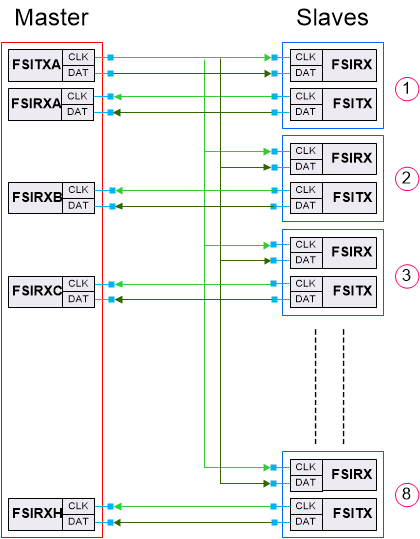SPRACR6 April 2020 TMS320F280023-Q1 , TMS320F280023C , TMS320F280025C , TMS320F280025C-Q1 , TMS320F280041-Q1 , TMS320F280041C , TMS320F280041C-Q1 , TMS320F280048-Q1 , TMS320F280048C-Q1 , TMS320F280049-Q1 , TMS320F280049C , TMS320F280049C-Q1 , TMS320F28384D , TMS320F28384D-Q1 , TMS320F28384S , TMS320F28384S-Q1 , TMS320F28386D , TMS320F28386D-Q1 , TMS320F28386S , TMS320F28386S-Q1 , TMS320F28388D , TMS320F28388S , TMS320F28P650DH , TMS320F28P650DK , TMS320F28P650SH , TMS320F28P650SK , TMS320F28P659DH-Q1 , TMS320F28P659DK-Q1 , TMS320F28P659SH-Q1
5.1 FSI Star Connection
In the star network connection shown in Figure 15, all slave devices connect to a single master device. The master broadcasts a message via it’s FSITX port, which in turn is connected to all FSIRX ports of all slave devices. All the slaves respond via their FSITX ports, each of which are connected to different FSIRX ports on the master device.
 Figure 15. Devices (MCUs) Connected in Star Topology
Figure 15. Devices (MCUs) Connected in Star Topology F2838x MCU supports 8 FSIRX ports and, hence, this topology can work up to 8 slave devices in the DPCA system. Thus, in a solar string inverter application one F2838x can control the DC/AC inverter stage as a master device and then 8 F28002x or F28004x MCUs, connected through FSI as slave devices, can be used for MPPT DC/DC control. In Table 1, it was calculated that a total of 7 F28002x MCUs are needed to control 24 MPPT DC/DC boost stages. Thus, the star connected configuration of F28002x MCU will allow control of 24 MPPT DC/DC boost stages in string inverter application with F2838x MCU controlling the DC/AC inverter stage as the master device.
F28004x MCU supports one FSI port and hence this star connected topology can work up to one slave devices in the DPCA system. Therefore, for the DPCA inverter system shown in Figure 13, there can only one F28004x MCU connected to one F28002x MCU when they are connected in a star configuration. However, the same system can be implemented using a different FSI configuration with multiple F28002x slave devices. This configuration is discussed in next section.
Some advantages of star topology are: easy point-to-point connection from slave to master and minimal latency in the communication as master broadcasts the message to all slaves and slaves directly respond back to master. In this configuration, the MPPT DC/DC MCU can send its voltage and current information to DC/AC MCU and offload some of the slower control tasks to that MCU. Such control tasks may include running the MPPT algorithm or calculating the panel voltage control loop output. DC/AC MCU can also calculate some system parameters such as, the total system power, MPPT voltage (for each DC/DC), and so forth, and implement system level control. This can also be used for rapid shutdown control where the inverter MCU sends the heartbeat signal to all MPPT DC/DC MCUs. As long as the DC/DC MCUs keep receiving the heartbeat they operate as normal. If they do not receive the heartbeat signal in the allocated amount of time they go into shut down mode. Star topology may result a higher cost to implementation depending on interconnect and isolation requirements across master and multiple slaves. The support is also limited to a maximum of 8 slave nodes with the F2838x device.